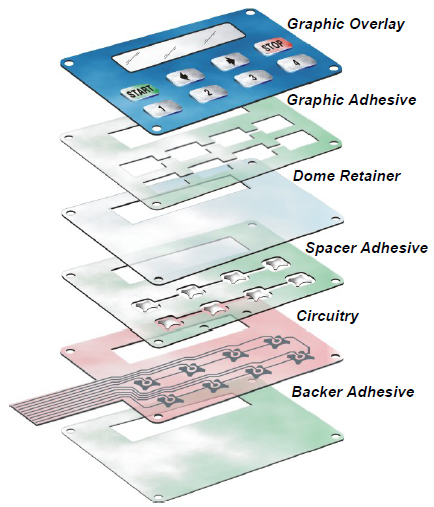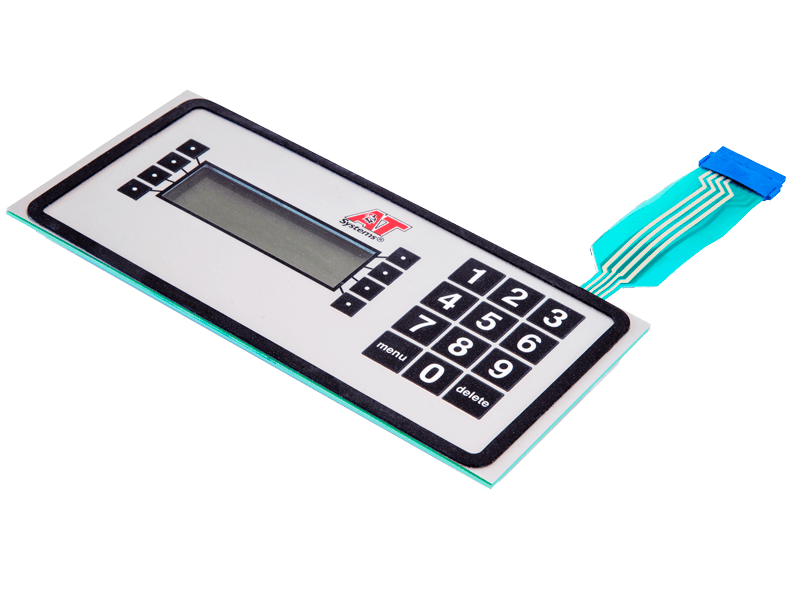Choosing a domestic membrane switch manufacturer can lower lead times and delivery costs.
Choosing a domestic membrane switch manufacturer can lower lead times and delivery costs.
Blog Article
Everything About Membrane Layer Change: Recognizing Its Layout and Capability
When you think about the control user interfaces in contemporary gadgets, membrane layer switches commonly come to mind. Let's discover what collections membrane changes apart from various other control systems.
What Are Membrane Layer Buttons?

Membrane buttons can likewise be tailored regarding shape, dimension, and graphics, permitting producers to develop distinct interfaces customized to particular items. On the whole, membrane layer buttons play a significant function in improving user experience across a wide selection of applications.
Exactly How Membrane Switches Job
When you press a secret on a membrane layer button, it triggers a simple yet reliable system. The leading layer, often made of versatile material, pushes down onto a conductive layer under it. This activity bridges the void between conductive traces, finishing an electric circuit. As soon as the circuit closes, it sends out a signal to the gadget's controller, which interprets your input.
You'll see that the responsive responses varies based upon the button style, offering either a soft click or a more noticable reaction. When you launch the trick, the membrane layer returns to its original setting, resuming the circuit and quiting the signal. This procedure takes place almost instantly, making certain a receptive individual experience.
Membrane switches are prominent due to their resilience and resistance to dust and dampness, making them ideal for various applications, from house devices to clinical tools. Comprehending this operation helps you appreciate their extensive usage.
Key Parts of Membrane Switches
Understanding the vital components of membrane layer switches is basic for comprehending their functionality and design. At the core, you'll discover the visuals overlay, which offers the visual interface for customers. Below that, there's a spacer layer that separates the circuit layers, making certain that they do not make contact up until pushed. The circuit layer is where the magic takes place; it includes conductive traces that complete the circuit when you push the button. One more crucial element is the glue backing, allowing the switch to stick to surfaces securely. The protective layer shields against ecological factors and put on, extending the button's life-span. Each element plays a considerable duty in making sure reliable efficiency and individual communication. By understanding these components, you'll acquire insight right into just how membrane layer changes operate and their importance in different applications.
Materials Utilized in Membrane Switch Style
The performance and sturdiness of membrane layer changes heavily rely on the materials used in their style. You generally come across polyester and polycarbonate as key substrates as a result of their exceptional toughness and adaptability. These products withstand scrapes and chemicals, making them suitable for requiring environments.
The conductive layers often utilize silver or carbon, chosen for their reliability and conductivity. membrane switch manufacturer. Silver provides remarkable efficiency, recommended you read while carbon is an economical alternative. For the overlay, you might think about a matte or shiny surface, relying on your visual requirements and customer experience
Make particular to select adhesives that withstand environmental aspects like temperature level and humidity. Picking the best products will assure your membrane button stands the test of visite site time.
Style Factors To Consider for Membrane Layer Switches
While developing membrane layer buttons, it's essential to consider numerous aspects that influence their functionality and individual experience. Start by focusing on the format and switch size; make certain they're instinctive and simple to navigate. Take into consideration the responsive responses you desire to provide-- will individuals need a recognizable click or a softer touch? In addition, think about the materials you'll utilize, as they'll impact sturdiness and appearances.
Verify your style accommodates ecological factors, like wetness or temperature level variants, which might affect performance. By meticulously considering these aspects, you'll produce a membrane layer button that boosts usability and satisfaction.
Applications of Membrane Layer Buttons
Membrane layer switches are flexible components found in numerous applications, from industrial equipment to customer electronics. You'll see their effect in equipments that require resilient user interfaces and in tools that take advantage of streamlined designs. Recognizing these applications aids you value the performance and practicality of membrane layer buttons in everyday innovation.
Industrial Tools Use
When you're aiming to improve the functionality of industrial devices, membrane layer buttons use a reliable solution that combines resilience with straightforward layout. These switches are perfect for rough atmospheres, giving resistance to dust, dampness, and chemicals. You'll find them in control panels for making machines, heating and cooling systems, and medical devices, where accuracy and responsiveness are essential. Their reduced account means they fit flawlessly right into various equipment, conserving useful space while preserving simplicity of use. With adjustable graphics and backlighting alternatives, you can develop an intuitive user interface for operators, boosting effectiveness and safety and security. And also, their long life expectancy lowers upkeep costs, making them a wise financial investment for your industrial applications. Welcome membrane switches to improve your procedures and improve total performance.
Customer Electronic Devices Combination
In the domain of customer electronic devices, membrane layer buttons play an important duty in anchor boosting user communication and gadget performance. Membrane buttons also assure longevity and resistance to dirt and dampness, prolonging the lifespan of your electronics. By selecting membrane buttons, you improve not simply the functionality but additionally the design of your devices, making everyday communications smooth and pleasurable.
Benefits and Downsides of Membrane Switches
While membrane switches offer an array of benefits, they also come with some drawbacks that you need to consider. One significant benefit is their portable design, making them perfect for space-constrained applications.

However, there are negative aspects. Membrane layer buttons can have a much shorter life-span compared to mechanical switches, especially under hefty usage. They can additionally be much less responsive, which might influence user feedback during operation. In addition, if damaged, repairing them can be difficult and usually needs full replacement. Eventually, their sensitivity to extreme temperatures and environmental conditions might restrict their effectiveness in particular setups. Stabilizing these pros and disadvantages will certainly assist you figure out if membrane buttons are the appropriate fit for your project.
Regularly Asked Inquiries
How Much Time Do Membrane Layer Changes Generally Last?
Membrane layer switches generally last in between 5 to one decade, depending on usage and ecological conditions. You'll want to evaluate variables like wear, exposure to wetness, and temperature variations to gauge their long life effectively.
Can Membrane Layer Switches Over Be Personalized for Certain Styles?
Yes, you can customize membrane buttons to fit particular styles (membrane switch manufacturer). You'll have the liberty to pick colors, forms, and formats that match your project's needs, ensuring they mix flawlessly with your general aesthetic
What Is the Price Array for Membrane Layer Switch Production?
The price range for membrane button manufacturing commonly falls between $1 and $10 each, depending on elements like design complexity, quantity, and materials. You can obtain quotes from producers to find the very best choice.

Are Membrane Layer Changes Waterproof or Resistant?
Membrane buttons can be created to be waterproof or resistant, depending upon products used and building and construction techniques. If you need them for damp environments, ensure you specify those requirements during the design process.
Exactly How Do Membrane Switches Compare to Traditional Buttons?
Membrane layer buttons are normally thinner and much more versatile than standard switches, using a sleek style. They're typically easier to cleanse and incorporate, but may not offer the responsive feedback you're used to with mechanical options.
Verdict

Report this page